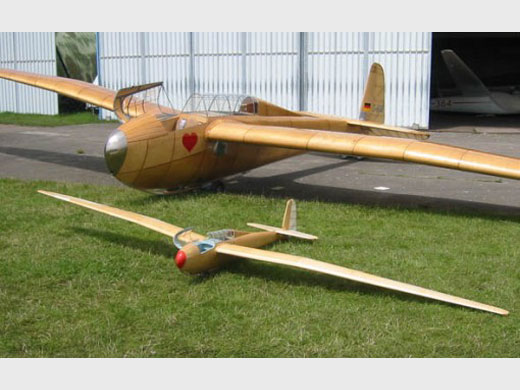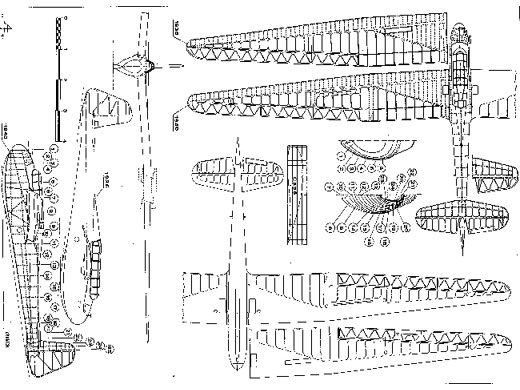
DFS Kranich-II
| DONNÉES GÉNÉRALES |
| Année du premier vol (ou de design, si seul projet) |
1935 |
| Pays | Allemagne |
| Designer(s) | JACOBS, Hans |
| Premier constructeur | DFS |
| Type d'appareil | Planeur |
| Fonction | Performance |
| SPÉCIFICATIONS TECHNIQUES |
| Envergure | 18 m |
| Longueur | 7 m |
| Hauteur | -- |
| Allongement | 14.3 |
| Surface alaire | 22.7 m2 |
| Profil aile | Göttingen 535 |
| Masse à vide | 185 kg |
| Masse maxi | 350 kg |
| Charge alaire | 19.4 kg/m2 |
| Vitesse mini | -- |
| Vitesse maxi | 175 km/h |
| Finesse maxi | 23.6 à 70 km/h |
| Taux de chute mini | 0.69 m/s à 51 km/h |
| Nb sièges | 2 |
| Structure | Bois et toile |
AUTRES INFORMATIONS
| Constructeur(s) |
| ||||||
| Infos techniques | Ailes en mouette. | ||||||
| Histoire résumée | The DFS Kranich is a German glider. It was developed by Hans Jacobs for the Deutsche Forschungsanstalt für Segelflug (DFS). Series production of the Kranich took place in the aircraft division of Karl Schweyer AG in Mannheim. The two-seater was in its version 2, the most widely built glider in Germany from 1935 to 1939. Several hundred examples were built; exact numbers are not known. On 11 October 1940 Erich Klöckner in a Kranich achieved the record height in a glider of 11,460 m. Because it occurred in wartime, the altitude record was not recognized by the Allied occupying powers, and Klöckner only received official recognition by the Fédération Aéronautique Internationale (FAI) in the late 1990s. [1] This record height was only exceeded ten years after the flight by the American Bill Ivans during a similar scientific program in the Sierra Nevada. In 1942 30 Kranichs were built by the Swedish manufacturer AB Flygplan in Norrköping, and delivered to the Swedish Air Force for training purposes. These machines were given the military designation Se 103. Between 1950 and 1952 50 examples of a slightly modified copy of the Kranich II were built in Poland, known as the SZD-C Żuraw (żuraw is Kranich in Polish = "crane"). After the war, the Focke-Wulf aircraft factory in Bremen developed and produced the Kranich III, which was a completely new development and shows no similarities with its predecessors. The first flight was on 1 May 1952, piloted by Hanna Reitsch. 37 examples of this type were built. | ||||||
| Plans | Liasse des plans constructeur numérisés (DVD) en vente au GPPA (Musée Espace Air Passion, Angers-Marcé). | ||||||
| Liens personnalités | JACOBS, Hans (Allemagne) | ||||||
| Exemplaires existants | |||||||
| Pack(s) photos | Immatriculation : PH-103. Photographié par Vincent Besançon (VGC Angoulême 2006) sur Rétroplane.net 18 photos, 3 Mo | ||||||
| Compléments docs |
SOURCES DOCUMENTAIRES
| Liens WEB | Site : UIUC Applied Aerodynamics Group's . Göttingen 535 airfoil. (2009-11-29) Site : UIUC Applied Aerodynamics Group's . Göttingen 535 fichier DAT. (2009-11-29) |
| Livres | Deutsche Segelflugzeuge par ZUERL, Hubert (1954) [p. 45. Note + plan 3 vues + specs]. Sailplanes 1920-1945 par SIMONS, Martin (2001) [p. 119. Note + plan 3 vues + specs]. Segelflugzeug Geschichten par SELINGER, Peter F. (2004) [p. 62-65. Texte + 4 photos + specs]. The world's sailplanes par OSTIV (1958) [p. 91, 93, 94. 3-vues + specs + description]. |
| Autres sources | The 3rd international Kranich meeting, VGC News n° 113 (hiver 2004) p 22-25. A very famous Kranich, VGC News n° 116 (hiver 2005) p 16-17. Chris Wills cède son Kranich 2B-1 BGA-964 aux Swedish Veteran Glider Pilots (Alleberg, SW). |

MODÈLES RÉDUITS
|
 Fiche n° 488 [Dernière mise à jour : 2011-05-12]
Fiche n° 488 [Dernière mise à jour : 2011-05-12]
Team J2mcL © 2003 -
- Pages optimisées pour Mozilla Firefox


